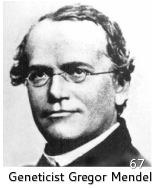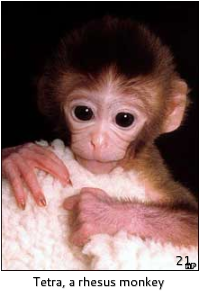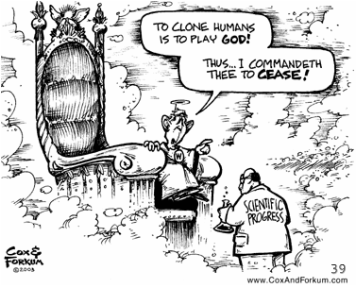CLONING
A Cloning over view...

People have been fascinated with the unknown, especially with DNA and genetics. The scientific world began with the invention of the Microscope 1608, and moved on to Gregor Mendel and his genetic work on pea plants and further experimentation with DNA and genes (101). Cloning was a real dream for scientist. They wanted to find out how to clone a living organism. Cloning is when you make an exact copy of an organism, meaning the two organisms have the exact genetic makeup and look identical. Clones are like identical twins, only clones are not produced biologically, they are produced by science. The great advances and achievements in Cloning came in the 1990s. The two greatest achievements in America during the nineties were, The Human Genome Project and Tetra the cloned monkey.
The Human Genome Project
The Human Genome Project started in 1990. Scientists, who took part in the Project were marking where genes were on chromosomes and making maps of those chromosomes (101). DNA holds the key to understanding why certain processes happen in organisms' bodies. And by knowing where the genes are on a chromosome, it is easier for scientists to find out how chromosomes work. Chromosomes also give organisms their genotype, which is their genetic makeup, and their phenotype, which is their physical traits of an organism. Knowing the genetic makeup of a person made it possible to see if there were reasons for certain diseases and disabilities.
September 1999 - Tetra

Tetra was the first monkey to be cloned by embryo splitting, which is when an eight celled embryo is split into two or four equal parts, and in Tetra's case the embryo was divided into four equal parts. Embryo splitting is like what happens when twins or triplets are formed (116). Tetra was the only monkey to survive out of the four embryos that were implanted into four surrogate mothers (59). Tetra has given new hope to the Scientific Community for finding new scientific methods of improving the lives of people through scientific research.
What did Cloning mean for America?
In the 1990s, cloning meant new opportunities for advancement and improvement. The Human Genome Project offered a lot of information about humans. Scientists believed that once the human genome was figured out science would get a push in the right direction in curing different types of genetic diseases (101). DNA is what runs everything in an organism's body, and once the human genome is figured out scientists will be able to find out why certain diseases happen and the gene that causes diseases and also how mutations are inherited (101). By knowing the genome of people it would be easy to determine if a disease was caused by a defected chromosome, which would allow scientists to screen people sooner and give people a better chance at survival if the disease is very dangerous. Soon after the Project was started, several new disease genes were found a month, unlike before the project which was a several being discovered a year (66). The biggest effect of the Human Genome Project was that it allowed scientists to explore the function of human genes, which would allow scientists to see how mutated genes caused diseases and disabilities. This information will lead to better drugs because scientists know how the genes work, thus allowing them to create drugs that target those specific genes which means fewer side effects from those drugs (66).
Tetra also gives insight into world of diseases. She has made it possible to further research to find cures for diseases (101). She was part of an experiment to produce identical monkeys, which would allow get rid of the genetic variability (101). These identical monkeys would have the same genetic makeup making it easy for scientists to create a vaccine or drug that would act the same way in all the monkeys, to better understand the effects of the drug or vaccine. Because primates are the closest relatives to humans, makes it easier to test new drugs that could be used to battle human diseases such as AIDS, heart disease, or cancer, because humans and primates share many of the same genes (59).
The Human Genome Project and Tetra made it easier to help the American public. They allowed new ways to explore the various human diseases and find ways to cure them. They made it possible to improve the American life, allowing people to live a healthier life because they gave information that was not available to scientists before 1990. Both Tetra and the Human Genome Project gave the American people hope, because once untouchable diseases and conditions were now being researched.
Tetra also gives insight into world of diseases. She has made it possible to further research to find cures for diseases (101). She was part of an experiment to produce identical monkeys, which would allow get rid of the genetic variability (101). These identical monkeys would have the same genetic makeup making it easy for scientists to create a vaccine or drug that would act the same way in all the monkeys, to better understand the effects of the drug or vaccine. Because primates are the closest relatives to humans, makes it easier to test new drugs that could be used to battle human diseases such as AIDS, heart disease, or cancer, because humans and primates share many of the same genes (59).
The Human Genome Project and Tetra made it easier to help the American public. They allowed new ways to explore the various human diseases and find ways to cure them. They made it possible to improve the American life, allowing people to live a healthier life because they gave information that was not available to scientists before 1990. Both Tetra and the Human Genome Project gave the American people hope, because once untouchable diseases and conditions were now being researched.
Ethical Issues RAISED BY CLOnING

The American public did have a lot of negative views on cloning. Many people feared that because Tetra is a primate and is a close relative to humans that soon scientists would start to clone humans (101). People feared that scientists would try and create a superior race. There is a difference between treating people and enhancing a races, and society feared that enhancement would happen (66).
People also hated the idea of experimenting on monkeys. People believed that monkeys were far from mice because monkeys are much more intelligent and compassionate; they are just like humans (101). There were concerns that scientists would create animals just to experiment on them. People also believe that the embryo splitting would lead to infertile people using embryo splitting to have children (116).
Finally people felt like the Human Genome Project would affect health insurance and the amount of coverage people would receive. Children would be checked when they were young to find out the child's risk for getting diseases that are related to genes. People believed that health care costs will be lowered because a person's risk of getting a disease is known, thus allowing people to figure out what they need and do not need. This would also allow people to take action sooner instead of waiting until the disease is too far along (66). Yet people feared that screening would affect insurance. They thought that people who are destined to have a certain disease meant that their insurance would be higher than people who are not destined to get a certain disease (66). The Human Genome Project and Tetra did raise some ethical questions in America. People were not quite ready for that type of change and were not ready for the actions that would get them there.
People also hated the idea of experimenting on monkeys. People believed that monkeys were far from mice because monkeys are much more intelligent and compassionate; they are just like humans (101). There were concerns that scientists would create animals just to experiment on them. People also believe that the embryo splitting would lead to infertile people using embryo splitting to have children (116).
Finally people felt like the Human Genome Project would affect health insurance and the amount of coverage people would receive. Children would be checked when they were young to find out the child's risk for getting diseases that are related to genes. People believed that health care costs will be lowered because a person's risk of getting a disease is known, thus allowing people to figure out what they need and do not need. This would also allow people to take action sooner instead of waiting until the disease is too far along (66). Yet people feared that screening would affect insurance. They thought that people who are destined to have a certain disease meant that their insurance would be higher than people who are not destined to get a certain disease (66). The Human Genome Project and Tetra did raise some ethical questions in America. People were not quite ready for that type of change and were not ready for the actions that would get them there.
Nicole Gallup
